A map of the open innovation ecosystem
These changing times
People and organisations are naturally resistant to innovation. Humans tend to settle into repeatable behaviour to be safe and secure. We repeat actions that resulted in past success and build defences to protect against future change.
Rather than keeping us safe, this behaviour is more likely to result in career or corporate extinction. A recent CBRE report on the future of work and the workplace predicts that over 50% of occupations will be redundant by 2025. People in these professions will be without work as entire industries go the way of the VHS tape.
Industries are being threatened by emerging business models that bypass traditional institutions. The “Uber of everything” movement removes the middle-man and replicates a direct-to-order approach for most any profession you can think of, including house cleaning, massages, food delivery, and doctor visits.
Even my current profession of management consultant is disrupted by the likes of Expert360 which offers “top consulting talent on demand”. Such disruptions are forcing large consultancies to respond in-kind, with dominant consultancies such as Deloitte, KPMG and PWC creating marketplaces that offer consultants at reduced rates for certain types of work.
Larger institutions can find it difficult to respond to smaller, more nimble start-ups rapidly grabbing market share. Organisations face the need to become “ambidextrous”, exploiting current strengths with one hand while simultaneously exploring new opportunities with the other.
Rather than be seen as a negative, this disruption is referred to as a “creative destruction” where economic growth and structural change force less productive firms to exit and allow more innovative firms to enter. Traditional innovation programs attempt to keep up with the rate of change. Corporate internal programs such as Adobe Kickbox, LinkedIn [in]cubator, Ericsson Ideabox, and Atlassian ShipIt mobilise staff to think of new ideas for their respective companies.
There are, however, limitations inherent to an internally-managed innovation program. Internal innovation can be limited by the boundaries of the organisation, technology can change faster than the institutions’ ability to keep up, and a sense of safety can provide a lack the motivation inherent to the competitive fires of the external market. Addressing the complex challenges in a changing landscape can be difficult from within the walls of a personal or organisational perspective.
The innovation ecosystem continues to evolve to address these challenges.
The open innovation ecosystem
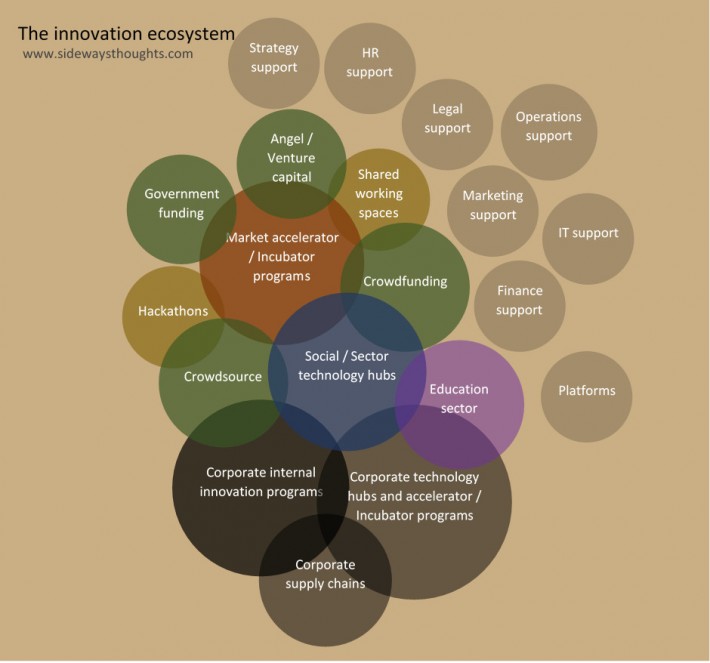
The innovation ecosystem refers to the various programs, projects and institutions that come together to deliver innovation. This interaction works based on a premise that innovation is more likely at the interface between boundaries. The model above attempts to show the different parts of the system and provide an idea of which parts interact.
For example, corporate supply chains are inherently associated with internal corporate programs and technology hubs, but have limited commercial drivers for their involvement in incubator programs unless those suppliers become the corporate or help facilitate the conversation (e.g., Microsoft or SAP). Incubator programs utilise a range of funding models such as crowdfunding, crowdsourcing, government funding or venture capital, but those models may not interact and collaborate themselves. Market incubator programs bring together a diverse range of finance and support functions, whereas corporate programs have access to these within the corporation. These are not hard and fast rules, but rather some observations based on generalities of who plays with who in the emerging open innovation space.
The point is that not all parts are in play at the same time. Rather, models are emerging that pick and choose aspects based on the complexity and drivers of the situation.
A few additional caveats before we get to the list:
- The list below is far from exhaustive
I did not intend to create a new list of lists of open innovation programs. There already exist some exceptional ones by the likes of Stefan Lindegaard, We Thinq, Board of Innovation, or the Compass ranking of start-up ecosystems. - It is not one size fits all
Organisations may have multiple programs across many areas. The intent is not to be complete, but to test examples. - Open innovation will be common very soon
The concept of “open innovation” will become “innovation” much like “corporate social responsibility” is becoming how many corporations do business and “social media strategies” now comes part and parcel with communication strategy. I may revisit this in a year or so to see if the model evolves, similar to previous efforts with my three-year review on a social media taxonomy. - A map is only a representation
Any model by its nature reduces the complexity of the situation into a few common variables. Mapping innovation can be like defining roads that are constantly under construction. This is one example to add to the Google image search for open innovation ecosystem. - The space is evolving and this is one perspective
My reflections are that of an investor, mentor, and corporate coach and facilitator in the space of culture, strategy, innovation, and organisational change, as well as a budding start-up founder. My perspective is one at a single point in time. There are others with deep knowledge and experience who live in the innovation and start-up area on a daily basis (such as We Thinq’s Christian Kreutz’ introduction to the current open innovation space). In the spirit of open innovation, I add my voice to contribute and welcome perspectives from those with experience in a rapidly emerging field.
The corporate approach
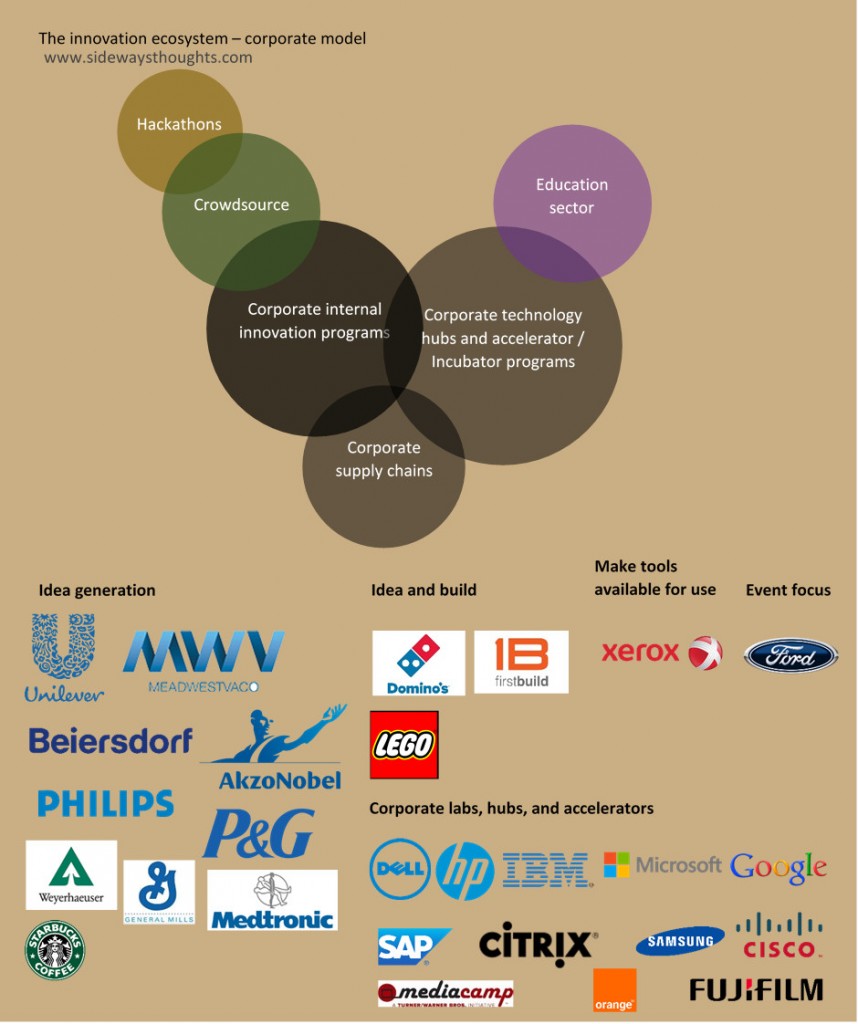
Corporations have an inherent need to foster innovation to drive profit and long-term sustainability. The open innovation approach comes with risks, however, as outlined by McKinsey a few years back.
A few models are emerging to access input beyond the organisational boundaries. The effectiveness of the model can vary. It can seem a bit rich too ask everyone to give ideas and intellectual property only to give a prize to one person for an amount seemingly less than the value of the idea. The reward is often an access to new markets or employment opportunities, or when the outcome has a greater social benefit.
Idea Generation
- My Starbucks Idea
Powered on the SalesForce platform, coffee people can offer ideas in exchange for… reinforcing their identity as coffee people. - General Mills G-Win
Like Starbucks, G-Win is also powered by SalesForce. Unlike Starbucks, there were precisely zero ideas submitted on G-Win at the time of this post. This may be reflective of the platform configuration more than the program’s history, as there are previous success stories from the G-Win program. - Beierssdorf Pearlfinder
Pearlfinder is the platform for the German skin care company to receive ideas (“pearls”) from the market, primarily the scientific community. - AkzoNobel Open Space
The Dutch coating company has created its own Open Space for idea submission and engagement. - MeadWestvaco (MWV) Open Exchange
An open innovation program by an American packaging company. The last idea on the site appears to be from about three years ago, not sure how active it is. - P&G Connect and Develop
American consumer goods company Procter & Gamble’s Connect and Develop program engages with a range of idea opportunities, supported by a dedicated business development team. - Weyerhaeuser
This is an example of highlighting the risk mitigation and exposes challenges faced by corporates in opening their doors to ideas. On the one hand, the timber company has a tagline of “Innovation for more than a century”. On the other hand, the process for engaging with the company around innovation is notably restrictive. Before submitting an idea, they make sure you know that: “Typically, we consider unsolicited ideas or inventions only when they’re protected by an issued, or pending, patent. We rarely commercialize unsolicited ideas, inventions or collaborations – many submissions are duplications of past research and development, while others often fall outside the scope of our business interests.” If you are still keen, you proceed through three pages of terms and conditions before downloading and completing a paper form, physically mailing it in, and waiting 60 days for a response. - Medtronic
Medical device company Medtronic invites engineers and scientists to share their ideas. - Unilever
The consumer goods company is open to working with anyone who will help them with their Unilever Sustainable Living Plan. - Phillips Open innovation
The Amsterdam-based electronics company invites partners to participate with them in “outside-in” innovation.
Idea and build
Those who develop ideas have the opportunity to see their ideas executed and made available and to be a part of that process.
- Lego Design byME and Lego ideas
Lego’s previous Design byME program allowed people to submit their own designs for build. The current Lego Ideas program allows people to submit ideas for voting and eventual selection for build, with the winner receiving a royalty on all sales. - Domino’s Pizza Pizza Mogul
The Australian flavour of the global pizza company shows that innovations of menu are as valued as innovations of process and technology. Pizza Mogul allows you to create your own pizza and make your pizza available for purchase to earn money for yourself or for charity. - GE FirstBuild
Build your own appliance in this partnership between Local Motors and GE. The program is part of GE’s holistic approach to open innovation.
Make tools available for use
Organisations make tools available for use that others can use to interact with their services or pilot before market release.
- Xerox
Xerox offers technical tools for people to play with and provide feedback if they are so inclined.
Event focus
An innovation program with a focus on a period of time and a specific outcome, such as when a company offers a public challenge or promotes a hackathon type event using their technology.
- Ford mobility challenge
Ford encouraged people to solve mobility challenges with the release of its OpenXC software and hardware platform to encourage developers to experiment with Do-It-Yourself projects using real-time vehicle data.
Corporate labs, hubs, and accelerators
A mention is needed for the advanced range of innovation programs developed by technology companies. These companies recognise the role of technology in innovation and want to ensure it is their technology that is used in those innovations. An interesting entrant to this space is the Time Warner media camp, an accelerator for technology for the media industry.
The Google for Entrepreneurs program is also expansive in its position as a program to create more hubs globally. The related Google Startup Grind and other startup communities expand the remit of the search engine giant across the open innovation ecosystem.
- IBM University
- Dell Ideastorm
- HP Labs
- Microsoft Ventures
- SAP Co-innovation Lab (COIL)
- Cisco Internet of Everything (IoE) innovation centres
- Samsung Accelerator
- Citrix Accelerator
- Turner / Warner Media Camp
- Orange start-up accelerator
- Fuji Film Open Innovation Hub
- Google for Entrepreneurs
Social / Sector hubs
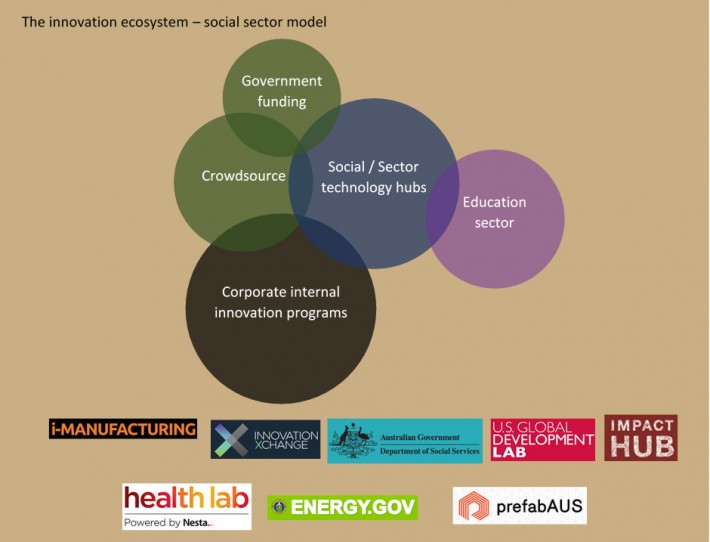
Sector hubs can address competitive pressures that can come with corporate-driven innovation such as perceived self-interest agendas and risk of loss of intellectual property. Sectors are defined by the focus area, including industry segments (health, manufacturing, construction) or topics (poverty, disease, technology aspect). The more broad the sector, the greater the number of likely participants. The sponsor of the hub is usually a joint venture, association, NGO, or government department.
It can be difficult to distinguish between what is a formal program and what is simply a co-working space, as the term “hub” is used for both. A 2014 Worldbank blog post identified over 90 technology hubs across Africa, with the blog comments highlighting the challenge with capturing a list in such a rapidly growing and evolving field. InnovationManagement.se has a good overview on what makes for a successful open innovation hub.
A few hubs are listed to show examples of what can be considered in this space:
- Australian Government’s InnovationXchange
An Australian Government sponsored approach to innovations in aid and development, with a line of sight to ideas from and a 4-year, $30 million investment in the Global Innovation Fund. - South Australian Innovation Hub
An Australian state-based response that focuses on aged care. - U.S. Global Development Lab
A hub within USAID that brings partners together to achieve the end of extreme poverty by 2030. - Impact Hub
A global initiative of over 69 hubs that are part innovation lab, part business incubator, and part community centre to create impact. - Meta i-manufacturing hub
A collaborative network of high potential manufacturing businesses and researchers to connect manufacturers to customers and suppliers more seamlessly and to provide a significant boost to efficiency. - Nesta Health Lab
The UK-based innovation charity has set up multiple labs to address a range of health-related social challenges and bring together their work on health and ageing to achieve more impact. - energy.gov innovation hubs
The United States government has set up a number of innovation hubs, including the Consortium for Advanced Simulation of Light Water Reactors, the Joint Center for Artificial Photosynthesis, the Joint Center for Energy Storage Research, and the Critical Materials Institute. - PrefabAUS
A hub for testing and proving innovation in the construction industry, with a focus on prefabrication.
The education sector
The education sector plays a key role in the innovation ecosystem across the models. As much as educational institutions face the challenge of preparing students for a constantly changing future, they also produce the entrepreneurs of today with reports ranking universities based on their ability to produce venture capital-backed entrepreneurs.
Universities are in a key position to develop their own innovation labs such as you might find at Harvard or Stanford. Universities balance the “come to us” or “go to them” strategies with a range of collaboration and partnership models. On a large scale, Cornell Tech is leasing a third of a building in the US$2 billion, 12-acre technology hub in New York. Other smaller examples occur where local universities provide low-rent shared working spaces for external technology hubs.
To be relevant in the innovation space, educational institutions also acknowledge the need to engage with business. The OECD Science, Technology and Industry Scoreboard 2013 ranks universities based on their collaboration with business, with Australia ranked at the bottom with between 3.5 and 4.1 percent of businesses collaborating with universities. This challenge is being addressed through initiatives such as plans by the Australian Mathematics Sciences Institute to double the number of PhD internships into business over the next five years.
Open market model
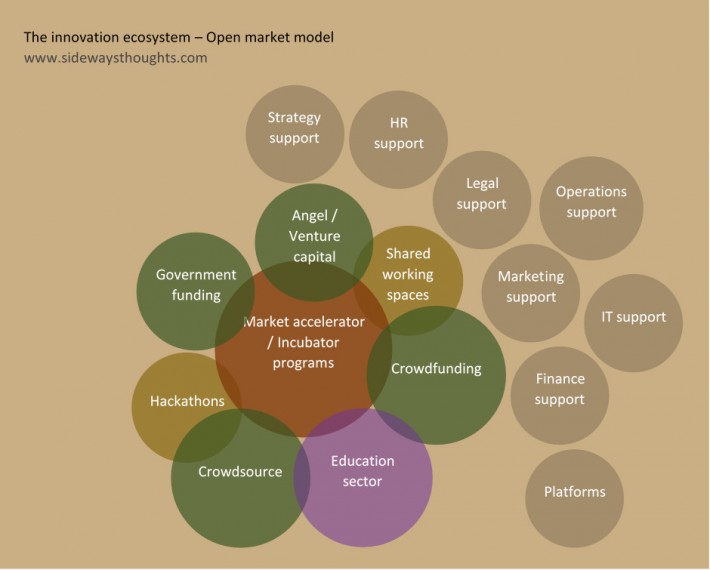
An open market model of innovation has emerged to fill a gap created by the challenge of institutions to keep pace with the rapid rate of technology advancement. New technical skills are being created faster than the pace at which education institutions can create curriculum. Students are trained for jobs that will soon be obsolete. Corporations invest in manufacturing lines and sales channels to deliver a product that will no longer be required or accessed in new ways.
Various programs and service providers are being patched together to create agile and efficient paths to market to meet emerging requirements using new technologies. Much like we saw in the early days of social media, the messy and unstructured nature of this new world is creating opportunity for those who can best integrate the pieces.
Market accelerators and incubator programs
Accelerators and incubators create a path for ideas to get from here to there. They do this through programs or curriculum that address the range of challenges typically experienced by a start-up.
The programs vary in the extent that they include or partner with the varied aspects of the process. For example, a venture capital funding organisation may have its own accelerator, or an accelerator may utilise multiple funding channels. An incubator program may have its own shared working space or leave it to the entrepreneur to find their own space.
There is a blurred difference between accelerators and incubators. The general sentiment is that the name reflects the outcomes, with incubators suited for early stage development and accelerators expediting growth.
I won’t begin to list these, as they are regional and diverse. At the time of this blog post (August 2015), there are 3,719 incubators on Angel.co, 8,980 programs listed on f6s.com, and 234 seed accelerators and groups listed on seed-db.com.
As is the case in any rapidly developing shift in society, you will get varying levels of quality. Professor Tim Mazzarol provides a good outline of when an accelerator provides value.
Within this are also programs that focus on the education aspect as well as specialising on an industry focus such as social enterprise. Two exciting local examples I am watching closely include the Impact Academy and the School for Social Entrepreneurs.
Angel / Venture capital
I lump Angel and Venture capital together as forms of “other people’s money”. Rather than getting money from a bank in exchange for interest, you are getting money from one or more individuals or funds often in exchange for equity ownership in the intellectual property or outcomes.
When taking money, organisations ask what they are getting for the money that they couldn’t get from a bank or the Quickie-Cash loan guy down the street. The start-up receives:
- Money
They have it and a line on more if needed, with acceptable terms. - Technology integration
The ability to connect into other businesses or technology to increase market share and distribution channels. - Market reach
The ability to rapidly expand reach into new markets (industry sector, regional) - Operations
The ability to connect with development and delivery channels for efficient capacity and scale. - Reputation and integrity
The start-up would feel comfortable and even proud to say they worked with the funding body and have the start-up’s logo on their web page. If you are receiving money from a loan shark off the street, this may not be the case.
Crowdfunding
Crowdfunding sites like Kickstarter have emerged as a means to get funding by the general public. These options are many and diverse, and again I will leave it to others to create the lists. Wikipedia has a good comparison, as does Marketing Moxie, CrowdFundBeat, An Entrepreneurial Life, and Crowd 101.
Rather than having two minutes to pitch to sophisticated investors a la Shark Tank, you are creating a pitch that will connect to the minds and emotions of millions. This in itself is a skill, with crowdfunding recommendation lists and Ted talk sessions explaining how to realise crowdfunding success.
Crowdsource
Crowdsourcing is like crowdfunding, except you are receiving ideas and labour instead of finance. Some may contribute out of goodwill in the case of a social enterprise, while others may ask for reciprocal gain. Wikipedia has a good list of crowdsourcing examples, most related to corporate solutions, and Crowdsourcing.org has a substantial directory.
Government funding
Local and national governments have a vested interest in supporting market innovation. Government bodies are typically risk averse and are unlikely to fund speculative projects that are more attractive to venture or angel investors. Governments are also not in the position to compete with the local market and take equity. What they will ask for in return for funding is strict reporting and the opportunity to share the success story to promote changes in their constituency.
Government funding is typically aligned to their role in supporting market facilitation and commercialisation. Examples I have experienced include facilitating connections to international export markets, sponsoring a trade show presence, provision of coaching and mentoring, and matching grants for operational improvements. What is not included is paying the founder a salary to start the endeavour or pay for the initial build of the product.
Funding is only one mechanism for government influence. Policy decisions and tax structures also play a critical role in the health of a country’s innovation ecosystem. A 2014 EY report on “Global venture capital insights and trends 2014” highlights government funding as one of the most important funding sources for entrepreneurs. A 2013 Google sponsored report by PwC titled “The startup economy: How to support tech startups and accelerate Australian innovation” highlights the role of government for both policy and as a one of the largest buyer of services. The influence of government is a significant contributor to national examples such as Israel (referred to as the start-up nation), Eastonia (a case study in a national approach to digital security), South Korea (#1 on Bloomerg’s 2015 list of innovative countries), and China (a PwC report titled “China’s innovation is going global: 2014 China innovation survey” shows innovation is the #1 priority for 42% of Chinese companies, as compared to 21% for other multi-nationals).
Shared working spaces
At the most basic level, a shared work spaces creates the environment for innovation to happen. We see examples in libraries and academic institutions that create a space with discount coffee, access to internet, drop-in mentors, and technology workstations to bring people together. Other market examples are emerging that charge rent for a desk in a cubical or open floor plan.
The shared spaces often incorporate events and training sessions where local leaders in the support services (lawyers, investors, strategists, etc.) are made available. These shared working spaces can eventually connect with accelerators to run their curriculum. A local example is Stephen Baxter’s shared space of River City Labs, which recently partnered with accelerator muru-D.
The shared work space may seem like it plays a minor role, but I can attest to the need in this area. The options to meet and work on a start-up are limited after traditional working hours. Unless it is your proverbial garage, the next best option is a hotel lobby, with rent being in the form of a $5 drink per person for an evening of brainstorming around a table.
Hackathons
Hackathons offer a separate, focused experience to build and prove a business model. I shared research and personal experience on hackathons in my previous post about Random Hacks of Kindness.
Hackathons can act as a “Hub-light”, getting people involved in innovation without requiring a long-term engagement. PwC has positioned their government-sponsored Open Innovation Platform as a form of hub, getting people together for events focusing on specific outcomes.
Other programs can use separate hackathons as a means to prove their model and provide hackathons with quality projects to trial. My experience with Random Hacks of Kindness had two quality projects that had been through the Impact Academy, while the School for Social Entrepreneurs partners with Atlassian for the facilitation of hackathon sessions.
Support network
The support network is everyone else involved in supporting a start-up idea get to market. These are the functions that are typically in-house and subsidised in a corporate model. In an open market, these services need to be patched together to support the start-up in the right way at the right time.
This can be disruptive even for the support services. The professional services network of lawyers, consultants, and software developers are often designed for a traditional fee-for-service business model operating on a high hourly rate. This model does not support a boot-strapped start-up that would only last a week paying $1,000 a day. Paying a large percentage of your total capital to someone telling you how to grow your business is counter-productive if you then have nothing left to fuel that growth.
Alternative models are emerging to align these services with the specialised needs of an open innovation network. One option is for the consultancy to take equity in exchange for services. Others have posted thoughts about such things at Taking equity in start-ups as a consulting firm, The benefits and risks of consulting for equity, and HHMI has a policy document outlining their approach to engaging for equity. The consultancy acts as a form of investor, building a portfolio of projects that involve both speculative equity and fee-for-service.
Platforms
A final part of the system includes software platforms that are emerging to support and help facilitate the open innovation ecosystem. These platforms often focus on the process of idea generation and selection. I will not go into detail apart from providing a list below of a few examples.
Open innovation for a positive difference
Innovation happens at the boundaries. The emerging open innovation ecosystem intentionally crosses boundaries to respond to a rapidly changing world. It is also the only way we will be able to address the complex challenges and opportunities facing humanity.
The rapid changes are creating opportunities, and the open nature creates space for more and more people to play. The question is not whether we can participate, but what difference we want to make when we participate.

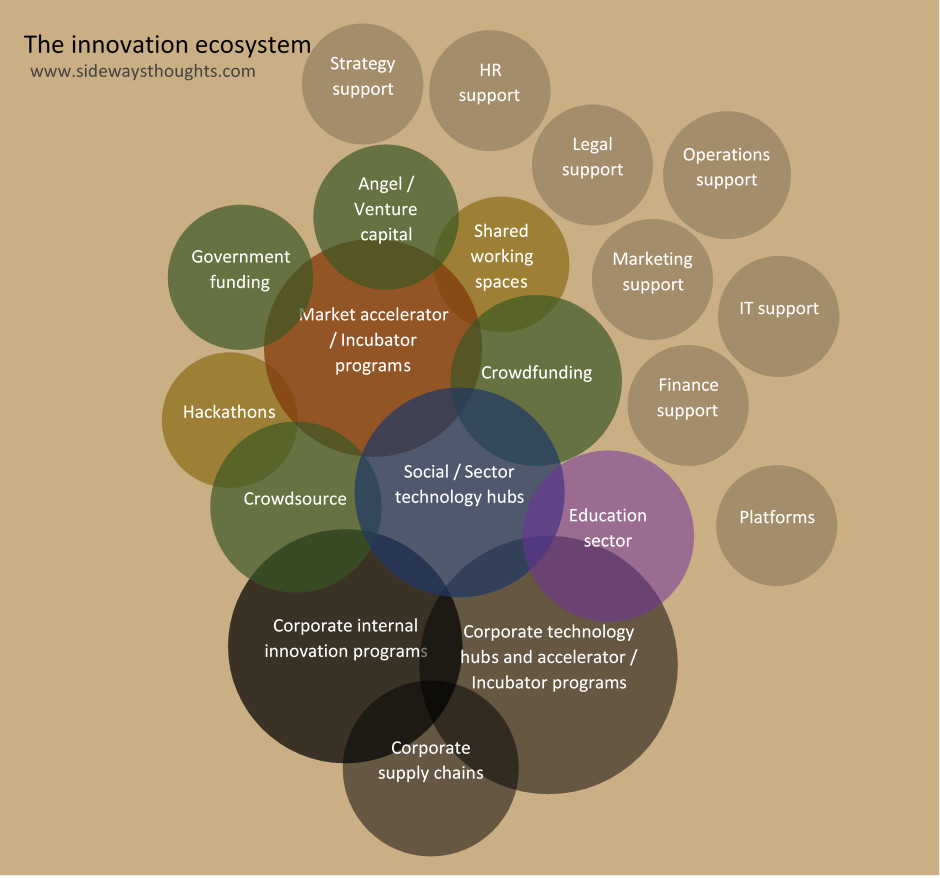
4 thoughts on “A map of the open innovation ecosystem”
Comments are closed.